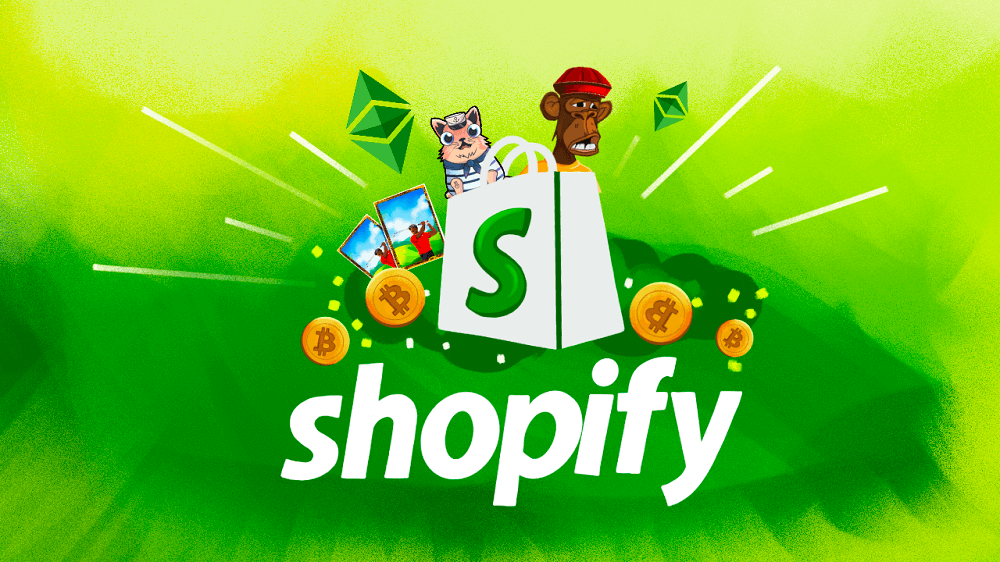It may have been easy to miss but over the last year Shopify has built out an ecosystem that accepts over 20 cryptocurrencies and allows the sale of NFTs. After all the OpenSea NFT marketplace has grown to a valuation over 13 billion dollars, seemingly every day we hear about massive sales and revenue from anyone in the space. Yet for some reason this latest product feature recieved little fanfare when it was announced last year. Nevertheless the marketplace is ripe for development and a perfect oportunity for traditional e-commerce brands to enter the Web3 space without disruption to business.
A quick recap of terms used in this article:
NFTs are called non-fungible tokens, and they are most popularly used to prove ownership over digital copies of media or ownership, such as digital artwork, music, tickets, and many other uses.
Minting is the process in which an NFT is created. When an NFT is minted, it’s given ownership and recorded on a digital ledger called a blockchain. The most common blockchains for minting NFTs are Ethereum, Solona, Polygon, Near, and Flow. You manage any NFTs that you mint or own through a crypto wallet.
Crypto wallets are digital accounts that process transactions of cryptocurrencies, such as Bitcoin or Ethereum and popular examples of companies Coinbase, Exodus, and Mycelium. You must have a crypto wallet to mint or purchase an NFT. The ownership history of an NFT is easily traceable and verifiable by the public.
Tokengated Commerce is when a specific section of the e-commerce experience is restrict to only allow users who have purchased and verified ownership of an NFT. There are many partners and applications to work through to do this on Shopify.

Why should brands explore NFTs?
Ther answer to this question is simple $$$. The Chicago Bulls were one of the first to utilize Shopify for NFTs, yet many other brands out of the ecosystem were left scrambling.
That is why we saw Nike acquire RTFKT, a start-up that drops 3D sneakers as NFTs and their first NFT collaboration sits a price of about 2eth or $3800 dollars per NFT.
This March, Gucci released 10KTF Gucci Grail, an NFT collection that plasters Gucci clothes on big-name NFT collections such as Bored Ape Yacht Club, World of Women, and Cryptoadz. The collection has a floor price of 0.8 ETH and has 3.5K ETH in total volume traded.
There are quite litteraly hundreds of other examples to look to of major brands entering the space to quickly cash in but the real opportunity lies in the unique ability to provide early launches, custom content, and unique experiences to your consumers. Enter Tokengated Commerce and Shopify leading the charge.
Tokengated Commerce: The Future of E-Commerce Brands
Tokengated commerce takes your typical exclusive access on steroids. Think about it as a a VIP pass to early arrivals, ability to buy prototypes, design samples, exclusive events, and so much more.
Lets explore a real world use case of a luxury designer handbag company and how they can both create an NFT collection and then use this to create a tokengated commerece solution that provides longterm loyalty, community, and revenue.
- Partner with an NFT Agency: The first step is to work with a NFT agency to help launch the project through creation, smart contracts, and promotion. This is easy for a designer brand as they already have a dedicated customer based who would be interested in VIP access and exclusive offers.
- Educate your customers: As with this article the NFT space is relatively new to most people and as such any project should go into the space with the idea of needing to educate thier customers on the how and why of NFTs. This process is relatively simple through a video or email flow utilizing some of the great content already on the market or creating your own.
- Design the program: Following the designer brands ethoes they will build out a list of exclusive things that will be held behind the tokengate. The first will an exclusive purse only available to holders, the second will be an exclusive section on black friday, the third will be access to all sample pieces and 1/1 handbags.
- Go Live: With all the above in place and executed its time for the best part of entering Web3 the benefits. First and foremost revenue, it is very common for brands to be able to make 5x to 10x their average item value on a token gated NFT concept. Thus a designer brand with $1,000 dollar hand bags could see NFTs selling for $5000-$10000 dollars to a select audience. In this case we would expect 1,000 NFT sales for millions in additional revenue. After the launch users could continue to sell the NFTs and at every sale the business will collect royalties.
- Foster The Community: This is your most loyal and ardent community of support and customers therefore you should do everything as a brand to keep them that way. From community groups and events, to exclusive brand partnership offerings you truly have a world of opportunity on how to build and grow the power behind your NFTs. The more you do to foster the community the more your brand and business will grow.
Wrapping up: What Shopify is doing to help grow this?
Despite the little fanfare its clear Shopify is dedicated to building this channel as part its platform. In the last six months multiple technical partners have been added and agencies are soon to follow. As the beta program has developed in the USA, Shopify has also grown its presence in the Web3 Community partnerning with with the Doodles NFT collection to host an IRL token-gated merchandise store.
Shopify has also partnered with crypto.com and strike along with a host of other blockchain and crypto currency companies to support the long term vision of this ecosystem. Simply put it would be smart for any brand in the Shopify ecosystem to start thinking about how they can capitalize on the newest e-commerce features.



